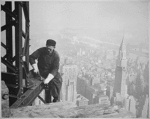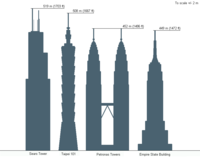Empire State Building
|
|
The Empire State Building, a 101-story contemporary Art Deco style building in New York City, was designed by Shreve, Lamb and Harmon Associates and built in 1931. The tower takes its name from the nickname of New York State.
The American Society of Civil Engineers declared the Empire State Building as one of the modern Seven Wonders of the World. The building also belongs to the World Federation of Great Towers.
Empire_State_Lobby.jpg
| Contents |
History and statistics
The Empire State Building's construction was hurried to completion, in order to take the title of "world's tallest building" from the Chrysler Building. It remained the tallest building in the world for many years, until the construction of the World Trade Center, and shortly afterwards the Sears Tower. As of 2005, following the September 11, 2001 attacks, it is the 2nd tallest building in the United States, and the tallest in New York City (see the 50 Tallest buildings in the U.S. list).
The building's distinctive spire was originally designed to be a mast and depot for zeppelins. However, after a couple of brief attempts, the idea proved to be impractical and dangerous, due to the powerful updrafts caused by the size of the building itself.
The building rises to 1,250 feet or 381 m at the 102nd floor. The Empire State Building was officially opened on May 1, 1931. Much of the office space went unrented until the 1940s. This lack of inhabitance earned it the nickname "Empty State Building" in its early years. A broadcasting tower added in the 1950s brings the total height to 1,455 feet (443.5 m).
A public observatory at the top of the building offers impressive views of the city, and is a popular tourist destination. Floodlights illuminate the top of the building at night, in colors chosen to match seasonal and other events; they were red, white, and blue for several months after the destruction of the World Trade Center, then reverted to marking holidays.
The building weighs approximately 330,000 metric tonnes. The building has 6,500 windows, 73 elevators, and 1,860 steps to the top floor. Total floor area: 204,385 m² (2,200,000 ft²) It is located at 350 Fifth Avenue, ZIP Code 10118, between 33rd and 34th Streets, in Midtown, Manhattan, directly across from Weehawken Cove, on the other side of the Hudson River.
Although the lower floors occupy the entire block, there are various "setbacks" in the building's design, as required by law at the time, to prevent the building from casting quite such a large shadow on its neighbors.
The building stands on a block once occupied by the original Waldorf Hotel, a haven for The Four Hundred, the social elite of New York in the late 19th Century. Previous to that, the site had first been developed as the John Thomson Farm, in the late 18th century.
1945 plane crash
At 9:49 a.m. on Saturday July 28, 1945, a B-25 Mitchell bomber accidentally crashed into the north side between the 79th and 80th floors, where the offices of the National Catholic Welfare Council were located. The fire was extinguished in 40 minutes. In the accident 14 people were killed. Empire State Building Withstood Airplane Impact (http://www.tms.org/pubs/journals/JOM/0112/News/News8-0112.html)
During the accident, elevator operator Betty Lou Oliver survived a plunge of 75 stories inside an elevator, and currently holds the Guinness World Record (http://www.guinnessworldrecords.com/content_pages/record.asp?recordid=53746) for the longest elevator fall recorded.
Urban climber
Without warning, in 1994, French urban climber Alain "Spiderman" Robert, using only his bare hands and feet and with no safety devices of any kind, scaled the building's exterior wall all the way to the top.
Skyline-New-York-City.jpg
Media
The Empire State Building has been described as "the most valuable building in American broadcasting". New York City is either the largest, or second-largest, media market in the country (depending on how one defines the rankings), and since September 11, 2001, nearly all of New York's commercial broadcast stations (both television and radio) have transmitted from the top of Empire. (A few stations are located at the nearby Conde Nast Building.)
Broadcasting began at Empire in the late 1930s, when RCA leased the 85th floor and built a laboratory there for Edwin Howard Armstrong. When Armstrong and RCA fell out, the 85th floor became the home of RCA's New York television operations, first as an experimental station and eventually as a commercial station WNBT, channel 4 (now WNBC-TV). Other television broadcasters would join RCA at Empire, on the 83rd, 82nd, and 81st floors, frequently bringing sister FM stations along for the ride. When the World Trade Center was being constructed, it caused serious problems for the television stations, most of which moved to World Trade as soon as it was completed. This made it possible to renovate the antenna structure and the transmitter facilities for the benefit of the FM stations remaining there, which were soon joined by other FMs and UHF TVs moving in from elsewhere in the metropolitan area. The destruction of the World Trade Center necessitated a great deal of shuffling of antennas and transmitter rooms in order to accommodate the stations moving back uptown.
As of 2005, Empire is home to the following stations:
- TV: WCBS-TV 2, WNBC-TV 4, WNYW 5, WABC-TV 7, WWOR-TV 9 Secaucus, WPIX-TV 11, WNET 13 Newark, WNYE-TV 25, WXTV 41 Paterson, WNJU 47 Linden, and WFUT-TV 68 Newark
- FM: WXRK 92.3, WPAT-FM 93.1 Paterson, WNYC-FM 93.9, WPLJ 95.5, WQXR-FM 96.3, WQHT-FM 97.1, WSKQ-FM 97.9, WRKS-FM 98.7, WBAI 99.5, WHTZ 100.3 Newark, WCBS-FM 101.1, WQCD 101.9, WNEW 102.7, WKTU 103.5 Lake Success, WAXQ 104.3, WWPR-FM 105.1, WCAA 105.9 Newark, WLTW 106.7, and WBLS 107.5.
The Empire State Building in pop culture
Empire_State_Building_Night.jpg
- Perhaps the most famous popular culture representation of the building is in the 1933 film King Kong, in which the title character, a giant ape, climbs to the top to escape his captors, and eventually dies by falling off of it. In 1983, for the 50th anniversary of the film, an inflatable King Kong was placed on the real Empire State Building. However, a mouse chewed through it one day, partially deflating the ape. He also needed a constant supply of air, and was never fully inflated.
- The observation deck was the designated site for romantic rendezvous in the films Love Affair and Sleepless In Seattle and a phony Martian invasion in an episode of I Love Lucy.
- The film Sky Captain and the World of Tomorrow opens with a zeppelin docking at the building's mooring mast.
- An episode of the puppet science fiction series Thunderbirds involves an attempt to move the building on tracks to a new location.
- In the movie Independence Day, the building is destroyed by a gigantic alien ship.
- In The Chase, a 1965 serial from the William Hartnell-era of Doctor Who, the Doctor, Barbara Wright, Ian Chesterton and Vicki, fleeing through time and space with a group of Daleks in hot pursuit, arrive in their TARDIS time machine on the Observation Deck of the Empire State Building (thus avoiding the long lines). They leave shortly after arriving and shortly before the pursuing Daleks' time machine materializes. The Daleks, ignoring the view, leave almost immediately.
- The building has a cameo role in the 1946 cartoon Baseball Bugs. Fitting the cartoon's theme, the skyscraper is labeled the "Umpire State Building".
See also
- 50 Tallest buildings in the U.S.
- Tallest buildings in New York City
- List of skyscrapers
- Skyscrapers in film
Some sources:
- The Empire State Building Book, by Jonathan Goldman, St. Martin's Press, 1980.
- Unbuilding, by David Macaulay, Houghton Mifflin, 1986.
External links
- The Construction of the Empire State Building, 1930-1931 (http://www.nypl.org/research/chss/spe/art/photo/hinex/empire/empire.html), New York Public Library.
- The story of Empire State Building (http://www.cbsforum.com/cgi-bin/articles/partners/cbs/search.cgi?template=display&dbname=cbsarticles&key2=empire&action=searchdbdisplay)
- Empire State Building: Official Internet Site (http://www.esbnyc.com/)
- Empire State Building web cam (http://www.mergatroyd.org/cam/esbcam.asp)af:Empire State-gebou
de:Empire State Building es:Edificio Empire State fr:Empire State Building it:Empire State Building nl:Empire State Building no:Empire State Building fi:Empire State Building pl:Empire State Building pt:Empire State Building sv:Empire State Building ta:எம்பயர் ஸ்டேட் கட்டிடம் zh:帝國大廈




